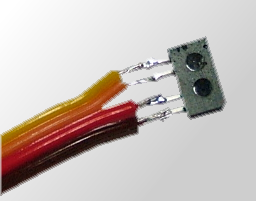| Brain-Wave Machine (And God said, Let there be light...)
Commercial brain-wave machines cost hundreds of dollars, but you can build your own using only a few dollars worth of components. In this document I will walk you through hardware construction and software control of an easy to build brain-wave machine. Disclaimer: I am not an electronics expert or a biofeedback specialist. If you fry your hardware (or your wetware) don't come whining (or drooling) to me. I assume no responsibility for what you do with this information. (Always yield to the hands-on imperative.)
I'm using 8 LED's, one per parallel port data out line. This provides an easy way to control each individual LED allowing for some variations in pattern and intensity. Each lense on the goggles will hold four LED's in a diamond pattern. The LED's are powered by the parallel port and controlled via software. Basic electronics experience is recommended but not necessary to construct this brain-wave machine. Parts List 8 LED's (choose green, yellow, or red LED's) DB25 pin male parallel port connector (or butcher a printer cable, 25 conductor) Goggles (safety glasses or similar eyewear) Wire Note: Radio Shack charges about $20 for 8 LED's. I got 20 LED's from a real electronics store for $3. Circuit Diagram Construction Browse the Brain-Wave Machine Image Gallery for pictures of readers goggles as well as modifications and variations. (Code is the essence of everything.)
BASIC The PC parallel port has eight data lines out. These data lines can be turned on and off by sending a byte to the port where each bit in the byte represents the on or off state of one of the data lines out. In BASIC you do this with the OUT function. The OUT function accepts two parameters, port address and a byte in decimal format. The most common addresses for LPT ports in hex are 378h, 278h, and 3BCh. LPT1 is almost always 378h, or 888 in decimal. The address parameter can be in hex (i.e. OUT &H378, #) or decimal format (i.e. OUT 888, #). Now let's take a look at bit patterns...
FOR i=1 to 50
OUT 888, 255
FOR x=1 to 500
NEXT x
OUT 888,0
FOR x=1 to 500
NEXT x
NEXT i
Obviously we need something better for timing than a FOR/NEXT loop. Unfortunately QBasic doesn't offer any timing functions with millisecond accuracy. Note: hz and cycles/second both refer to the flashrate of the LED's, so 15 hz = 15 flashes/second. I've written a small sample application which demonstrates one method of dealing with the timing issue in QBasic (using the SOUND function of all things). The program also has timed sessions, selectable frequencies, and three different flash patterns. Feel free to experiment with it. Sample QBasic App: BWM.BAS. Brainstar 1: Smoother interface and more features. Edit, save, and load patterns. QBasic source as well as a packaged run-time version are included. Contributed by Fractal (HardCore Software), May 6, 2000. Brainstar 2: Now with audio support, graphical session editing, and more. Contributed by Fractal (HardCore Software), October 4, 2000. Note 1: QBasic can be found on your Windows CD under OTHER/OLDMSDOS or search for olddos.exe on microsoft.com. Note 2: These programs will not work under NT unless a driver such as Direct I/O is utilized. C / C++ (This is your brain on Theta.)
You can use the brain-wave goggles with or without audio. However, the effects of the brain-wave machine are more powerful when used in conjunction with suitable audio. Many brain-wave stimulation and subliminal CD's and cassettes can be purchased from new-age bookstores. I highly recommend the "Brainwave Suite" 4 disc box-set by Dr. Jeffrey Thompson. Doctor Thompson has also produced several other brainwave CD's. Some Suggested Uses
|






0 comments: